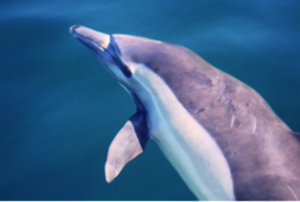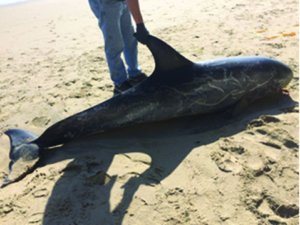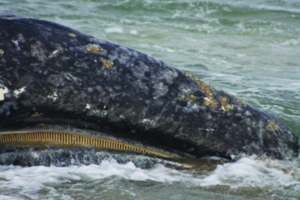Whale, Whale, Whale, Look Who We Have Here
By KC Scofield, Stranding Coordinator

Common Dolphin in the Wild
When walking along the shoreline here in Malibu it is not uncommon to see large Gray Whales feeding in the shallows, charismatic Bottlenose Dolphins playing in the surf, and even a breaching Humpback Whale out in the distance! Large mega-pods of Long and Short Beaked Common Dolphins can frequently be seen from the top of the Point Dume cliff, and Pygmy and Dwarf Sperm Whales thrive in our deeper waters offshore. The Malibu coastline provides a unique habitat to marine mammals both living in the area and just passing through.
Typically, the Marine Mammal department at California Wildlife Center is known for the loud cackles of chatty Elephant Seals or the splish-splashing of playful Sea Lions. While we are most often called to help pinnipeds (seals, sea lions) in need of help, our team also responds to a variety of cetaceans (whales and dolphins) every season.

Risso Dolphin
While many species of cetacean strandings are unpredictable, every year like clockwork between November and March we receive calls about Gray Whales. In the fall they migrate south to their breeding grounds in Baja California, Mexico, and in the spring they make the journey north to their summer feeding grounds in the North Pacific (the Bering Sea down to Northern California). This migration “highway” takes them right past Malibu. Many of the reports we receive are not of beached Gray Whales but of those that look “like they are trying to come on shore.” As a coastal species, you can frequently see them feeding in the shallows at Point Dume and Westward beaches. With benthic prey such as shrimp-like amphipods, being their favorite snack, Gray Whales are often seen in very shallow waters rolling on their side, swimming slowly, scooping up sediment, and leaving a trail of mud in their wake. To many, this may look like an animal in distress “trying to come on shore” and in need of help.
The Marine Mammal team responds to all reports that come in, this includes whales and dolphins on shore or in the water. When animals are in the water it provides our team an educational opportunity to share the life history of these local species. We share information like how Gray Whales feed, why dolphins like to surf the waves, and the migratory patterns of Humpback Whales.

Mouth of Grey Whale
On rare occasions a cetacean may meet the criteria for rescue. If so, the team works together to get the animal off the beach as quickly and safely as possible. On average CWC rescues eight individuals a year. While that may not sound like a lot, these animals require specialized equipment, particular protocols, and quite a few team members since they can be HEAVY (sometimes over 1,000 pounds). So far in 2022 we have responded to two Pygmy Sperm Whales, two Bottlenose Dolphins, one Northern Right Whale Dolphin, and we expect to receive more calls this winter. Other species we have responded to in the past have been, Gray Whales, Risso’s Dolphins, Humpback Whales, Long and Short Beaked Common Dolphins, Striped Dolphins and even a Fin Whale.
The Marine Mammal team responds to all reports that come in, this includes whales and dolphins on shore or in the water. When animals are in the water it provides our team an educational opportunity to share the life history of these local species. We share information like how Gray Whales feed, why dolphins like to surf the waves, and the migratory patterns of Humpback Whales.
On rare occasions a cetacean may meet the criteria for rescue. If so, the team works together to get the animal off the beach as quickly and safely as possible. On average CWC rescues eight individuals a year. While that may not sound like a lot, these animals require specialized equipment, particular protocols, and quite a few team members since they can be HEAVY (sometimes over 1,000 pounds). So far in 2022 we have responded to two Pygmy Sperm Whales, two Bottlenose Dolphins, one Northern Right Whale Dolphin, and we expect to receive more calls this winter. Other species we have responded to in the past have been, Gray Whales, Risso’s Dolphins, Humpback Whales, Long and Short Beaked Common Dolphins, Striped Dolphins and even a Fin Whale.
